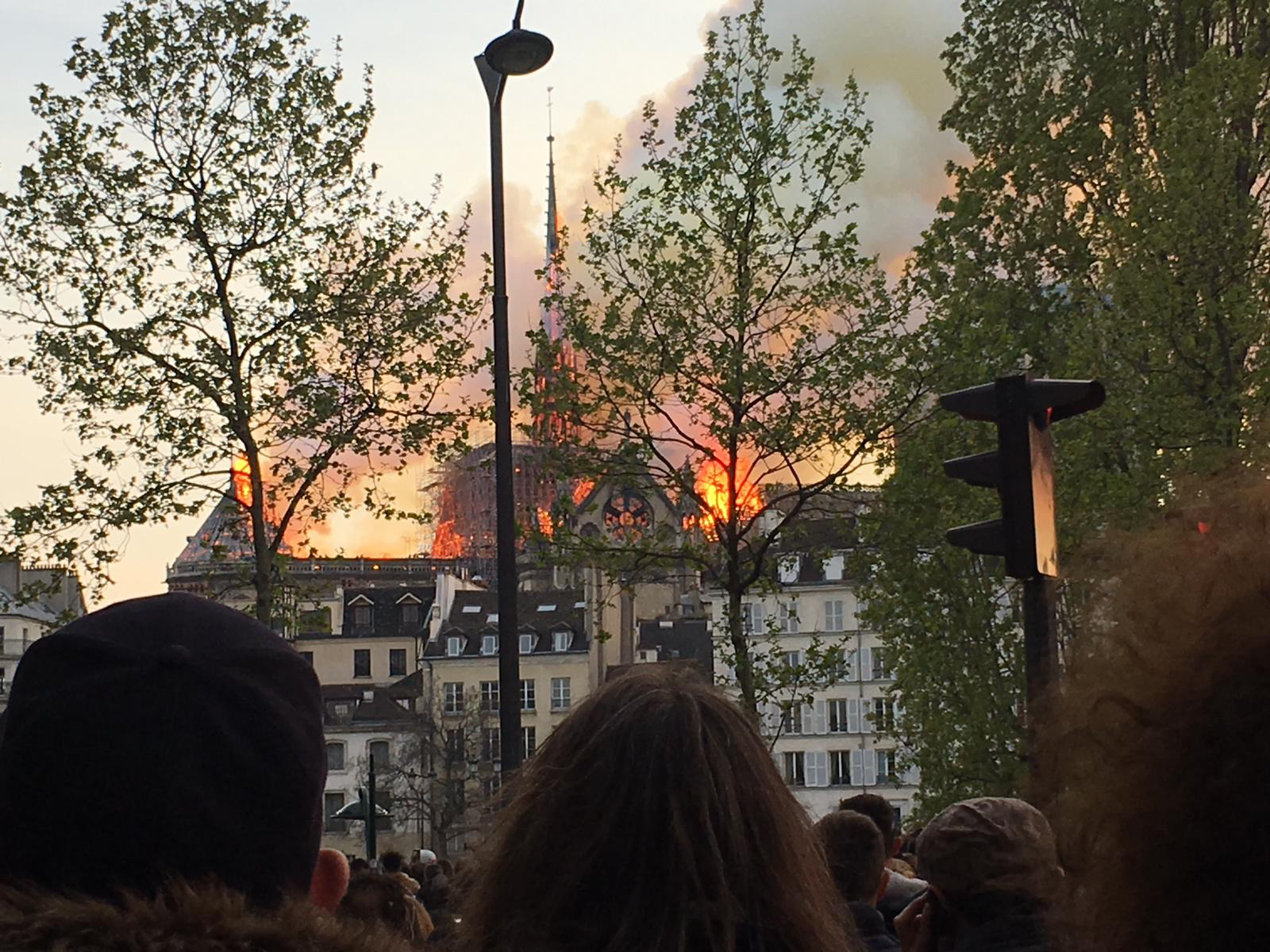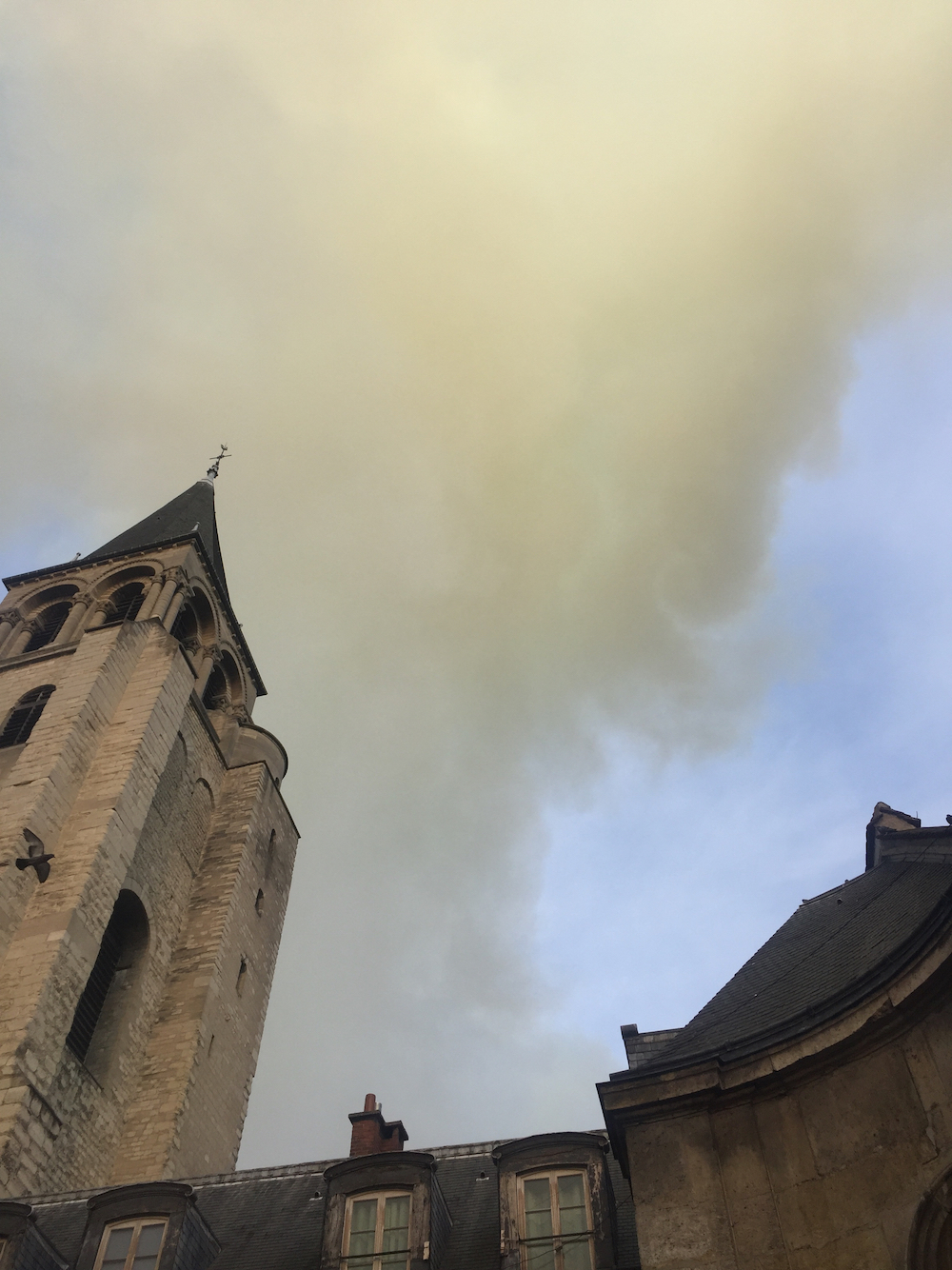Watching the Notre Dame fire from kilometer zero
The liminal space of studying abroad amidst national tragedy
April 19, 2019
 Courtesy of Corinne Vignon
Courtesy of Corinne VignonAlyce:
I watched the fire from across the river, just close enough to see firemen weaving through the filigreed belfries. As I stood in the smoke among the assembled crowd of tearful Parisians, someone started singing the “Hail Mary”—“Je vous Salue Marie” in French. The collective of voices individually soft, together huge and swelling, reverberated off the masonry of the Hausmannian apartments around the square, and even I—a nonbeliever from California—felt a shiver of, well, something.
Notre Dame is, of course, a Roman Catholic cathedral, and France is a historically Catholic country. For much of its history, more than 95 percent of the population identified as Catholic. During the Ancien Régime, church and state were inextricable. Bourbon kings were the heads of the French church and the executors of papal power within the borders. Notre Dame’s construction began in the 12th century, funded by a hefty stream of revenue sourced from the French people through a complicated system of taxes imposed both by the church itself and by the Monarchy.
In the first months of the 1789 revolution, the nascent Republic seized and nationalized church property across the country. Thanks to its size, status and sheer age, Notre Dame was transformed into a secular temple and used for civic ceremonies to honor the Cult of Reason, a revolutionary tradition established to wean the people off the outsized cultural influence of Catholicism.
Today, the cathedral and all its religious and artistic contents are property of the French state. A tacit agreement allows the Catholic clergy to hold mass within its walls as, essentially, tenants. This is why President Emmanuel Macron, rather than a Catholic cleric, was the first to address the nation from Îsle de la Cité on Monday night, and why the cathedral’s famous relic, the Crown of Thorns, is currently in the custody of a 59-year-old socialist, Anne Hidalgo, the mayor of Paris.
There is a particular irony in the tightness of this relationship. French politics of 19th century were largely animated by a struggle for control of national culture and education that pitted church against state. In the end, the State won, and since 1905, France has been helmed by legally secular “laïc” government. Religion has no formal place in French politics, neither in rhetoric nor in practice. French politicians are not sworn in on the Bible. Candidates for public office do not refer to the gospel in their stump speeches.
But on Monday, it was quite literally the government that saved Notre Dame. The Paris Fire Brigade is a unit of the French army and thus controlled, funded and trained by the national government itself. If not for the physical presence of these public servants in the northern belfry, the fire would have collapsed that most famous part of the façade, which dates to the middle of the 13th century.
It is the national government, rather than the Church, that will direct the cathedral’s restoration. It will take two to three million euros and around five years. The Ministry of Culture will collect and direct the funds, rather than the pope or the leaders of the French church.
Notre Dame therefore symbolizes Paris itself—culturally, historically and politically. The monument is dedicated to the Virgin Mary, mother of God and patron saint of Paris. It is the building and the city’s shared history of religion and revolution that made the civic pain of Monday evening so palpable and so powerful.
The city’s Latin motto is “Fluctuat Nec Mergitur”: “She is tossed by the waves but she does not sink.” By Tuesday morning, the work of rebuilding had already begun. Now, cranes punctuate the neighborhood’s blue-grey mansard roofs, lifting debris out of the nave, piece by piece. This week’s fire and the restoration that will span the coming years will stitch another layer of architectural and civic history onto a structure that has born witness to so much of what constitutes the nation’s identity and collective memory. What this will look like, what form the next chapter in the interwoven histories of Paris and Notre Dame will take, remains to be seen.
After hours of watching the red-orange glow shift and refract around the skeletal silhouette of the ancient cathedral, I headed back to my temporary Parisian home with the last lines of the “Salue Marie” in my ears.
“Priez pour nous, pauvres pécheurs / maintenant et à l’heure de notre mort.” Pray for us sinners / now and at the moment of our death.
When I got off the métro a little before midnight, I found the café below my host family’s apartment filled with young people sitting at the circular sidewalk tables, ashtrays full and wine bottles empty. Paris was doing what it has done so many times before: reflecting, continuing, living.
Vive la France.
Maia:
When I sat down for dinner on Monday evening the television was already on. This was an unprecedented occurrence in my weekly dinners with my host mother, Marie, and she made no effort to turn it off. We sat, instead, in tense silence, watching over plates of veal as the little box-set flashed with images of the crowds, the smoke and, of course, the flames lapping at the historic spire of Notre Dame de Paris.
At a break in the coverage, Marie turned to me, peeling back the living room curtain. She gestured to an ever-growing cloud of smoke rising from behind an adjacent apartment building.
“Before those apartments went up,” she explained, “you could see Notre Dame from this window.” The smoke continued to rise, she let the curtain fall and we retreated back into silence.
Marie is 77 years old, small and mighty with a distinctly Parisian spirit. Born in 1942, she is a member of a generation passed, a part of a Paris that no longer exists. I have been reminded this semester of all the change she has seen her city through: she was alive in ’44, when the Allied troops paraded down the Champs Élysées, marking Paris’s liberation; she was studying at the Sorbonne in the May of ’68, amidst the protests. She has raised three children and nine grandchildren in Paris. Now widowed, Marie resides in her ornate Haussmannian apartment, passing her days playing bridge and entertaining the occasional dinner guest. As you might have guessed, she isn’t pleased about the Gilets Jaunes either. “Tout bête,” she laughs every Saturday.
Monday’s fire marks a milestone in French history. Notre Dame is a symbol. It is Paris’ kilometer zero, the point from which distance is measured here. It is a piece of history in a city overwhelmingly rich with history, in a culture with fierce and unabashed pride for its past.
The gothic towers of Notre Dame have weathered many storms over the years. Construction of the cathedral began in the 12th century and was completed roughly 100 years later, though the building was subsequently modified for years following its completion. The cathedral’s frame, which burned so dramatically on Monday, is one of the oldest structures in Paris. Rather aptly nicknamed “the forest,” the frame was comprised of wood beams taken from some 1,300 oaks, or roughly 21 hectares of forest. As the story goes, the entire forest surrounding Paris was cut down to construct the impressive framework, an undertaking that transformed the landscape of the city from forest to metropolis. Sturdy, elegant, Notre Dame has stood tall through the French Revolution and two world wars. It has seen the coronation of Napoleon I, inspired the work of Hugo and endured the rise and the fall of empires and republics.
History, I’ve learned, is not something the French take lightly. As a visitor whose residency here expires abruptly on May 20, I have felt my position as a stranger to this history and to this place poignantly. I am never fully able to express myself or assimilate to the Parisian way of life; my classmates and I are not quite within, but after four months here, are certainly not without.
It is in this liminal space that we begin to ask the question of how much we can participate, how much we can partake. Can we really mourn national tragedy or, say, take a stance on the Gilet Jaunes alongside our Parisian peers, knowing fully well we will return to the comfort and the constancy of our lives in America? Is Notre Dame really ours to mourn? Watching the events of Monday evening through Marie’s eyes, I am reminded yet again of my status a tourist, an admirer.
Despite these considerations, this week I have felt a certain solidarity with my French peers, with my host mother. There was something in the hymns recited through dawn by Parisians outside the cathedral, something about such a communal tragedy that unified the city, Macronists and Gilets Jaunes, Americans and Frenchmen.
At the end of our dinner, Marie asked me not to worry, reassuring me that the fire was an accident, that tomorrow will be better. She smiled, excused me from the table and sent me off to bed. Later that evening though, I heard her slip out the door. Off to stand in solidarity with her countrymen, I assume, to join the hordes of Parisians gathered on the banks of the Seine watching the scene in awe, softly humming odes to their beloved cathedral.
Vive la France.
Comments
Before submitting a comment, please review our comment policy. Some key points from the policy:
- No hate speech, profanity, disrespectful or threatening comments.
- No personal attacks on reporters.
- Comments must be under 200 words.
- You are strongly encouraged to use a real name or identifier ("Class of '92").
- Any comments made with an email address that does not belong to you will get removed.


This commentary by American Bowdoin College Student, Alyce McFadden is the most tender, heart felt and poignant account of Notre Dame’s tragic fire in Paris that I have had opportunity ro see, hear, or had opportunity to share. I celebrate our many past and present American-French friendships and historical connections. Alice and her foster care mother, Marie obviously have cemented together the mutual love, respect and continuing relationships we Americans and the French people should support foreach other in the future.